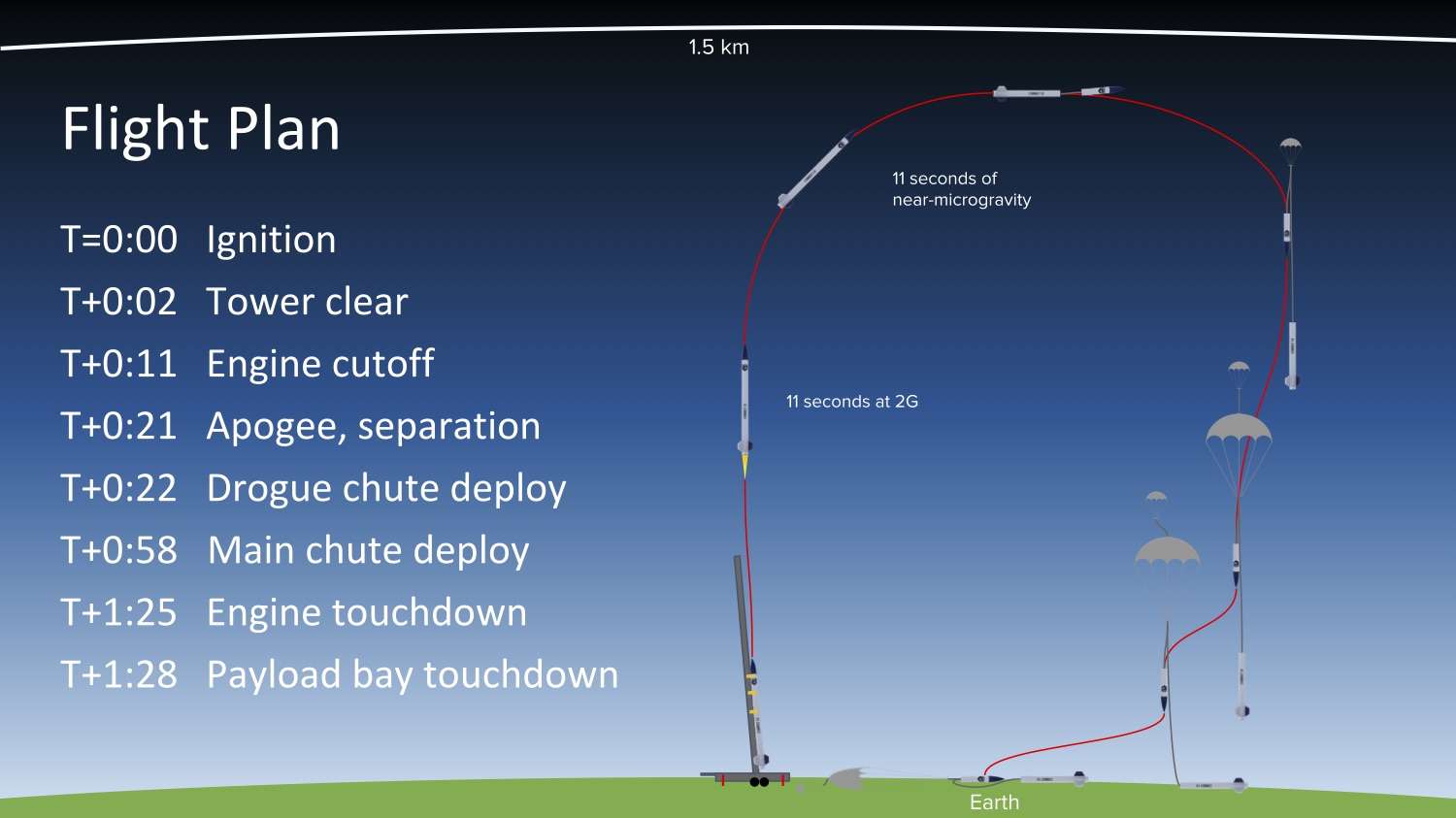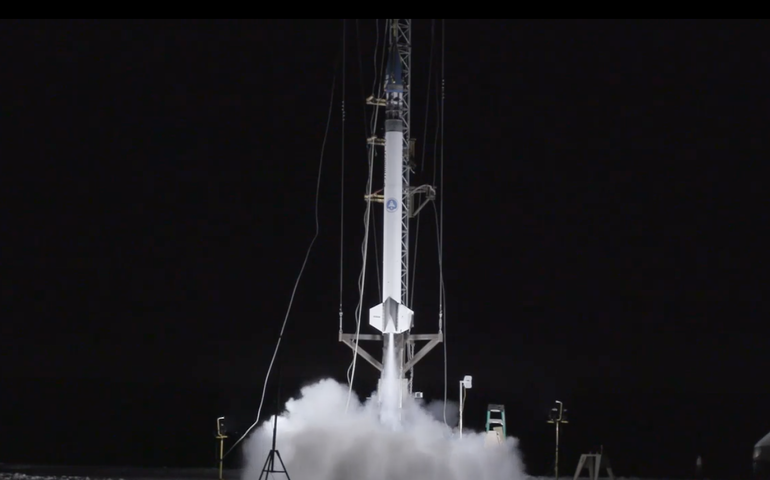
Long-awaited launch of bluShift Aerospace prototype rocket expected today
 Screenshot / bluShift Aerospace
Seen here is a screenshot of yesterday’s cold flow test.
Screenshot / bluShift Aerospace
Seen here is a screenshot of yesterday’s cold flow test.
There was excitement in the air on overcast Friday morning, as Brunswick-based bluShift Aerospace prepared to conduct the world’s first commercial launch of a rocket powered by bio-derived fuel, at Loring Commerce Centre in Limestone.
Viewers from around Maine and around the world, including NASA, tuned into a livestream of the launch. It was delayed several hours due to cloud cover. At press time, the new launch window was scheduled for 2 p.m. to 3 p.m., the bluShift commentator said, adding, “All systems are go on the rocket.”
View the livestream here.
If the launch needs to be scrubbed today, the new launch date will likely be set early next week, he said.
The bluShift team says the rocket is also fitted with five onboard cameras.
The prototype rocket, called Stardust 1.0, was equipped with a proprietary modular hybrid rocket engine that is also unique to the aerospace industry, according to a news release.

“Stardust has the potential to launch a vibrant aerospace industry right here in Maine,” said Sascha Deri, CEO and founder of bluShift Aerospace. “Our team of staff and investors is aiming high and hoping to create an ecologically responsible aerospace industry with the words ‘Made in Maine’ on it.”
Yesterday afternoon, bluShift conducted a “cold flow test” of the engine.
The test didn’t involve the use of fuel. It was designed to “test the plumbing” of the engine to ensure it would cool properly, as a bluShift commenter explained.
The rocket platform is a mobile trailer that allows bluShift to launch where it’s appropriate, based on permitting and availability.
The rocket was initially cleared to ascend 4,000 feet but by late morning was cleared to go 5,200 feet.
Powered by a non-toxic, carbon-neutral, bio-derived fuel made entirely from materials that can be grown on farms across America. Stardust 1.0 was designed to demonstrate a low-cost and reliable alternative to traditional fuel without sacrificing efficiency.
The MAREVL is designed so that it can be rapidly grouped in clusters and stages with other MAREVLs. The design architecture is expected to allow for the rapid assembly of custom rockets for suborbital and orbital missions.
"Gene, let's light this candle!” posted one livestream commenter, referencing the 1961 launch when astronaut Alan Shepard become the first American to voyage into space.
Wrote another: “I wish they used Loring more often for stuff like this.”

And referencing the location’s unique culture: “Game warden escorting moose off launchpad” and “Eating LSD at LemonWheel on the runway never would have thought I'd be going back to watch a rocket!” — alluding to the 1998 Phish concert at the former Air Force base.
The low-altitude demonstration launch of Stardust 1.0, was the culmination of six years of research and development, over 200 engine tests, the realization of grants from NASA and the Maine Technology Institute, and the development of a novel modular hybrid rocket engine called the Modular Adaptable Rocket Engine for Vehicle Launch or MAREVL.
The rockets are being developed to carry nanosatellites into suborbital space.
Last week, bluShift conducted a successful “static fire test” of its engine at Brunswick Landing, where bluShift is headquartered. A previous static fire test was conducted Dec. 22.
By building and launching rockets, bluShift hopes to stimulate an already-growing aerospace cluster in Maine. To date, bluShift has raised nearly $277,000 in capital investment from local and national investors. With the launch of Stardust 1.0, bluShift is poised to capture a sector of a quickly expanding market, creating 40 jobs in the next five years and supporting more across the state.
In addition to demonstrating the bio-derived fuel and other proprietary systems in flight, bluShift’s first launch was expected to validate growing demand for the suborbital launch of small payloads in small numbers.

Today’s prototype flight carried one academic and two commercial customer payloads.
Falmouth High School worked with the University of Maine and University of Southern Maine to outfit a cubesat prototype with a GoPro, radio transmitter and XinaBox chips to collect flight data including acceleration, pressure, temperature and humidity.
Physics and STEM teacher Andrew Njaa commented, “The cubesat experience is totally different from a normal science class. Our team of students got energized about space and Maine's place in it, and got a real window into what life in research, science, and engineering can be like.”
Njaa continued, “The students gave up weekends and spent hours over Zoom to troubleshoot and figure out new code. Cubesats are helping them build professional relationships with scientists and professors here in Maine and around the world. This is what BluShift, collaboration, and cubesats can do.”
Earlier this year Falmouth High School was among the five Maine schools awarded a NASA grant to launch MESAT-1, Maine’s first cubesat. The cubesat flown with bluShift will be their first 3U cubesat prototype.
Kellogg’s Research Labs will use this flight to test the vibration dampening properties of nitinol, a shape memory alloy of nickel and titanium, in the conditions of a rocket launch.
“We supplied parts for more than 100 satellites launched in 2019, and we’re just getting started” said CEO Joe Kellogg. “Currently 85% of cubesats arrive on orbit with major system damage. With the strength of titanium and the ability to convert the vibrations of a rocket launch into heat energy, nitinol can protect payloads for less weight than a separate vibration dampening system. Of course testing is critical, and that is where bluShift is able to help us open the door for expanding the use of nitinol in space.”
Rocket Insights, a software design and development company, brought the least conventional payload to the mission.
"We have deep connections with the state of Maine and love supporting innovators," said Rocket Insights partner Dave Witting. "When we heard that bluShift was taking on SpaceX and Blue Origin from the woods of Maine, we jumped at the opportunity to support this historic launch.”
The company filled their cubesat enclosure with traditional Dutch wafer cookies called stroopwafels, an homage to its Amsterdam-based parent company, Dept.
Mainebiz web partners
Sadly, the thick cloud cover at Loring never lifted and late in the afternoon, the launch was scrubbed til next week. But the hundreds of interested folks from all over the world followed the periodic weather updates and hours of commentary and conversation on the YouTube chat. There is so much enthusiasm, curiosity and excitement for this launch; people said they had fun anyhow, and will be back for the next attempt and will be hoping for good weather! BluShift is making waves!
Bon voyage










2 Comments